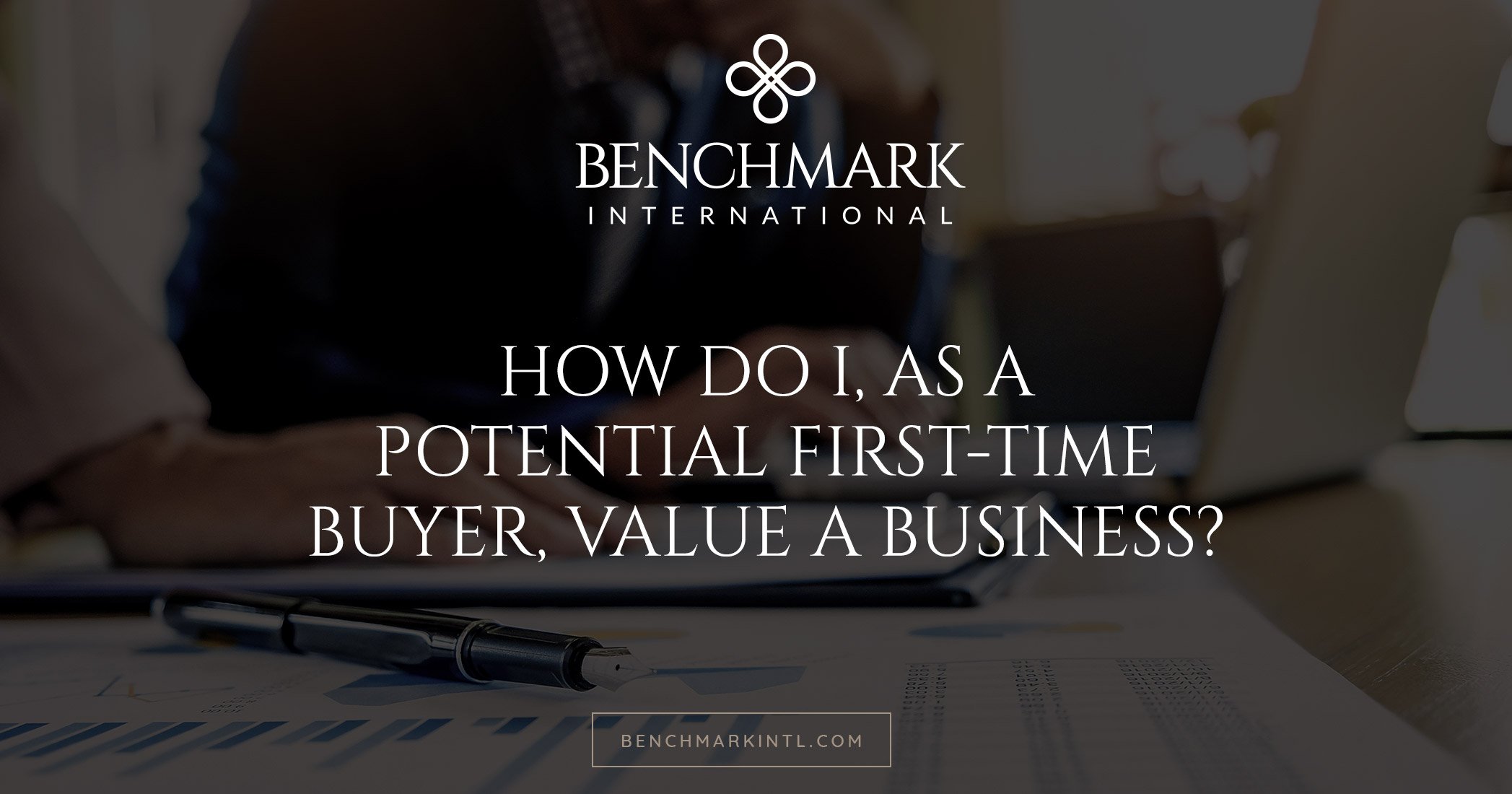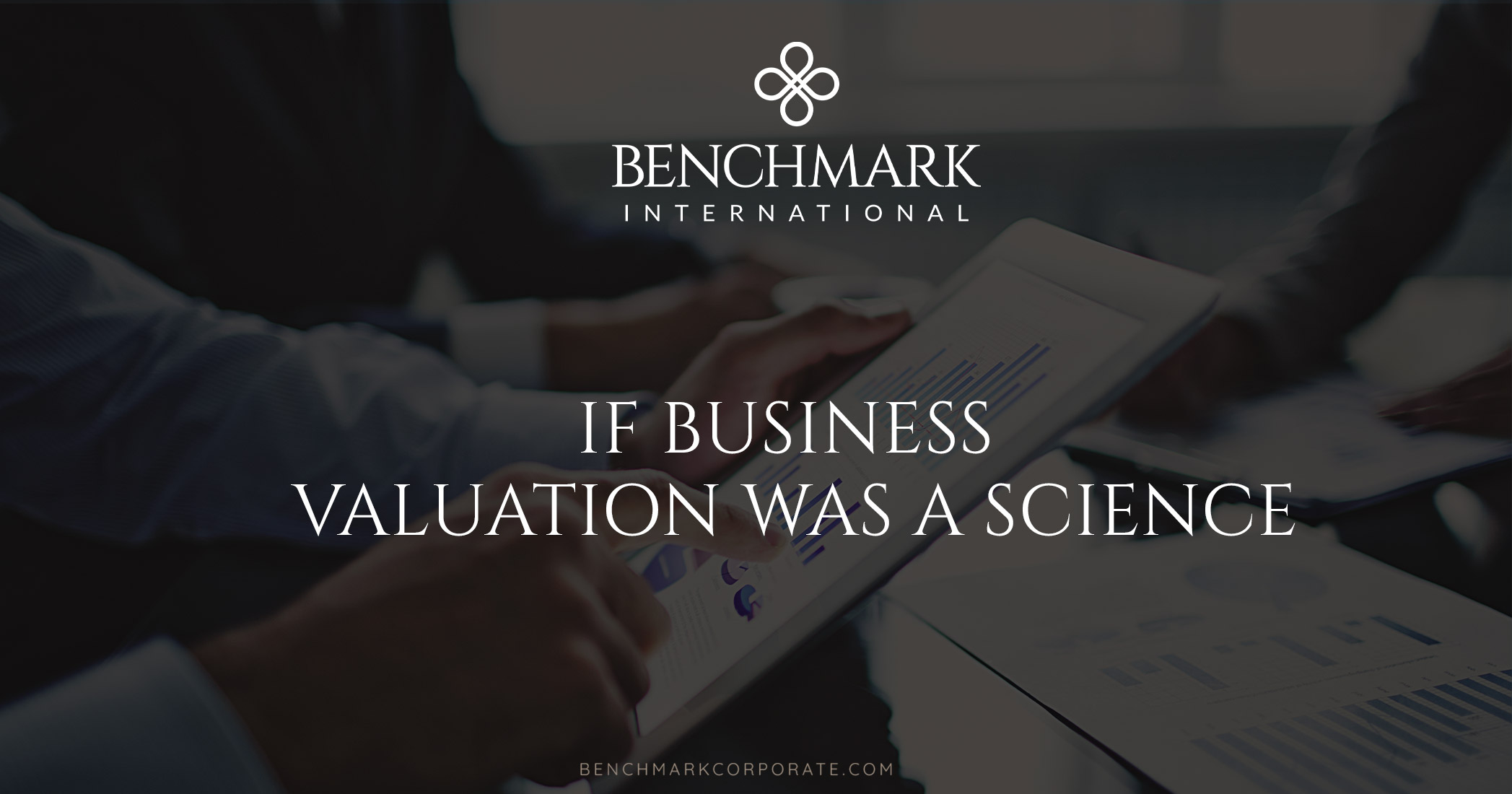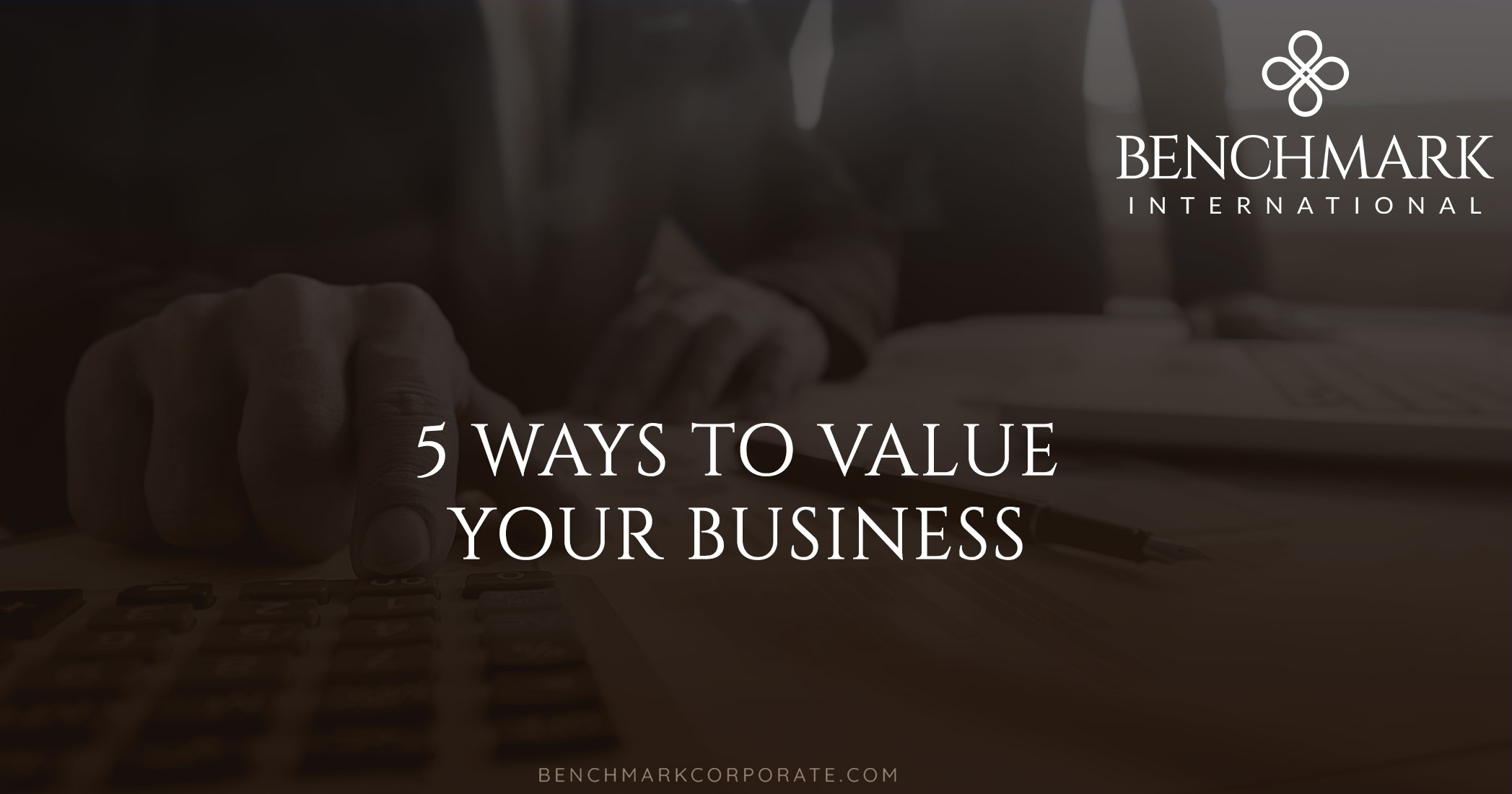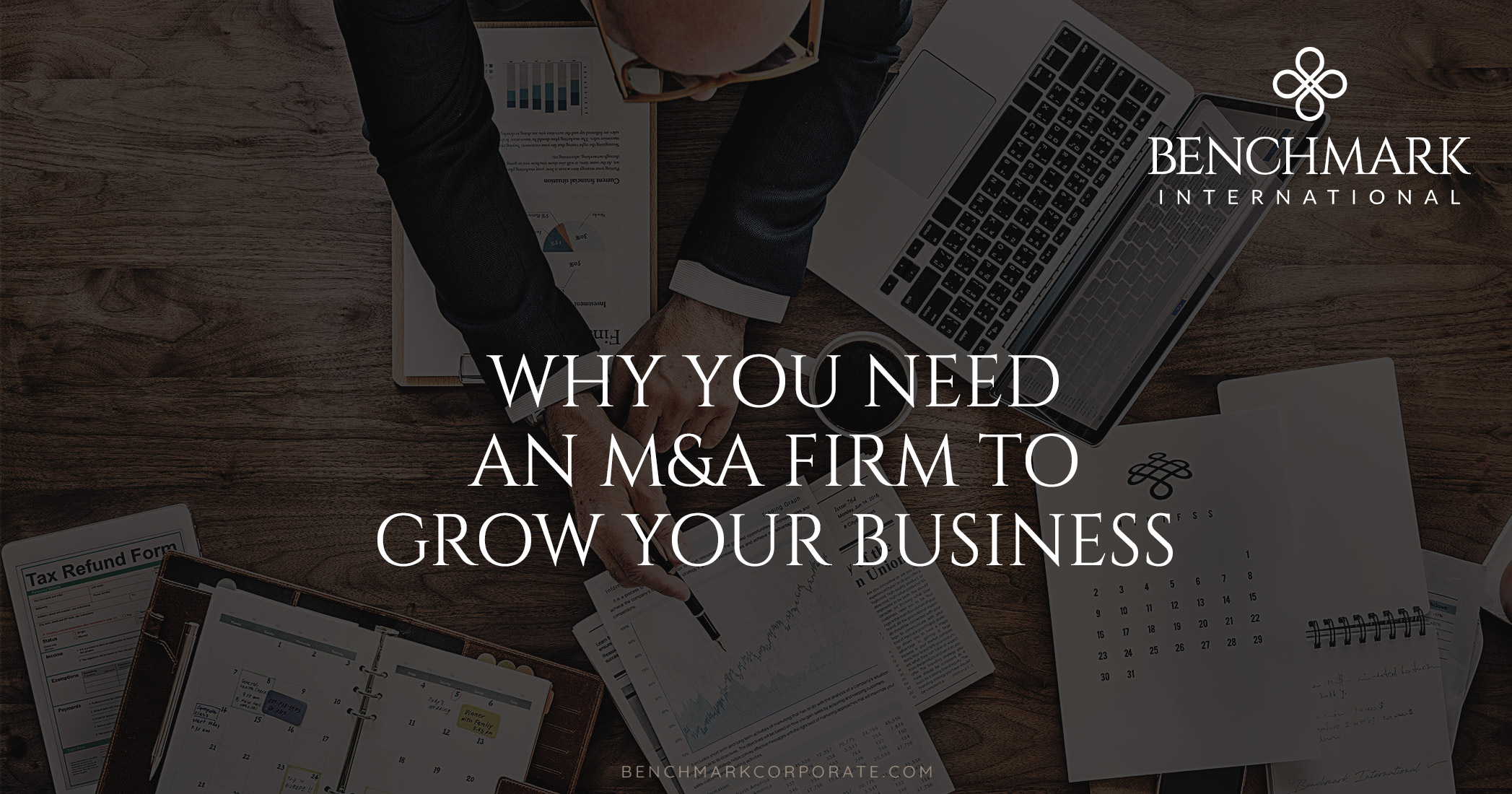When it comes to selling a company, quite a few factors need to be considered to extract the most value from a sale.
READ MORE >>Archives
When Is The Right Time To Sell Your Business?
What Is The Difference Between Selling A Business With Benchmark International Versus Without?
If you are considering selling your business, there are many reasons why you are better off with the guidance of a professional M&A team. There are many reasons why partnering with Benchmark International to sell your company can make a significant difference in both the process and the result.
READ MORE >>Share this:
Why Lower Middle-Market Companies are Attractive to Buyers
The lower middle market encompasses some of the most diverse selection of companies available to buyers, from “Mom & Pop” service shops to highly innovative technology firms paving the way for disruptive change at the highest levels. For this reason, lower middle-market companies have been the backbone of the U.S. economy from the very beginning—and remain so to this day. The value that these companies bring does not go unnoticed by the broader market, making this segment a high-activity space for engaged buyers and sellers. And motivated buyers are adept at spotting value, providing opportunities for well-informed sellers to maximize value on their exit.
Many companies at this end of the market operate in highly fragmented industries. From HVAC equipment providers and servicers to pool maintenance and other small businesses, you can see this fragmentation simply by driving around any local geography. When an industry is highly fragmented—and also highly profitable—it creates a “sweet spot” for both strategic and financial buyers. Private equity strategies, for example, will often follow a formula of buying a larger “platform company” then searching the lower middle market for smaller “bolt-on” acquisitions to grow the company from there. The strategy is often referred to as a “roll-up.” If done correctly, it can bring large returns for both the acquired company and the buyer. Strategic buyers (firms already operating in the same industry as the acquisition target) often regard M&A in this end of the market as a better way to grow market share versus slow and costly organic expansion.
Business owners and managers in the lower middle market are often looking to exit for retirement purposes. This reality can be advantageous for both buyers and sellers. Oftentimes, there is no succession plan in place heading into the retirement/exit decision and process. Many small businesses do not have a large chain of top executives that make a transition easy, and handing the business over to their children is often not a realistic option either. In other circumstances, the notion of selling the business comes up suddenly as a response to situations like health problems or other personal “black swan” events. In all circumstances, the right buyer—be they financial (private equity) or strategic—presents lucrative solutions that provide for the off-ramp and transition that ownership is seeking.
As such, there has been a large increase in demand for companies at this end of the market, as well as a corresponding awakening of ownership to recognize and test the benefits of a sale process. Investors are sitting on an ever-growing pool of capital that they are looking to deploy, seeking returns they cannot get elsewhere. The lower middle market allows investors of all stripes to purchase assets with relatively low debt (and, therefore, risk) compared to much larger companies. Additionally, the COVID-19 pandemic impact cannot be ignored when selling your business. COVID has hurt and even crippled a lot of businesses at the smaller end of the market. It also put an elongated pause in the mergers and acquisitions process. These two factors have led to pumped-up demand and lower supply, driving to significant increases in activity and deal volumes as the economy begins to pick up again.
When the time comes, business owners need to be ready to act quickly on sale opportunities. There are a lot of factors that go into selling your business. There will be different types of individuals and entities that come through to inquire about the potential acquisition of your company. While it might be tempting to jump at the first offer that comes, it is better to get a sound understanding of the wider market, and where the highest synergies/motivations (and therefore, the best valuations) can be found. There are always more opportunities to transact than one might think, and there are potential buyers out there for any type of company. The process of finding the right buyer always takes some “travel time”—with some speed bumps along the way—but a sound process that is run correctly can bring windfalls that will certainly justify the effort.
READ MORE >>Share this:
10 Factors That Drive Business Value Beyond Revenue
The value of a company extends beyond the amount of revenue it generates. As a business owner, you should be monitoring the value of your company at all times, but it is especially important if you are considering exiting or retiring within the next several years, or even up to a decade from now.
Company valuations are based on far more factors than just financial statements and multiples. The process involves the forecasting of the future of the business based on several key value drivers. Sometimes these can be sector-specific, but there are many core drivers that apply to any type of business, as outlined below.
READ MORE >>Share this:
Understanding Working Capital
Working capital, also referred to as net working capital, is the measure of a company's liquidity, operational efficiency, and short-term financial status. It is the difference between a business’s current assets, its inventory of materials and goods, and its existing liabilities. Net operating working capital is the difference between current assets and non-interest-bearing current liabilities. Typically, they are both calculated similarly, by deducting current liabilities from the current assets. So, essentially, if a business’s current assets total $500,000 and its current liabilities are $100,000, then its working capital is $400,000. But there are a few variations on the calculation formula based on what a financial analyst wants to include or exclude:
READ MORE >>Share this:
Helping Employees Find Meaning at Work
Many business owners know that employees are a company’s greatest asset. Yet, they are also a potential liability. According to CNBC, more than 3.5 million Americans quit their jobs every month. The current unemployment rate sits at 6.7%. It rose to 14.8% in April, but prior to the pandemic, it was 3.5%, which was a strong job market. So, if employees are so critical to a company’s operations, how can organizations mitigate the risk of them leaving, especially immediately before or after an M&A transaction? During such a transaction, a business may find itself at a disadvantage when trying to keep valuable workers in a strong job market and during the uneasiness of a transaction. Workers may feel under appreciated, underpaid, or that they lack opportunities for advancement during this period. Looking from the outside in, a culture like this can cripple the attraction of buyers or a successful integration.
In most cases, this can be averted. But how? Paying employees more? Giving out monthly awards or irrelevant promotions? In short, giving employees true meaning day-in and day-out can be a complex task but it’s a key differentiator in a company being a place where employees want to grow their careers, versus being a resume builder. Having a personal sense of who your employees are and what motivates them can often mean more to them than any compensation, and set the company up for a successful integration. The tricky part is identifying those things in which your employees find happiness, purpose and true meaning. Tackling the following key questions will improve your M&A transaction experience, increase employee retention, and help employees find greater happiness within the workplace.
What are your employees good at completing?
Performance reviews were implemented back in the 1800s and haven’t changed much since. Albert Einstein once said, “Insanity is doing the same thing over and over again and expecting different results.” Employers have been evaluating workers on a yearly basis and adjusting the company’s workforce according to their findings for many years. When evaluating employees, it’s important to include a detailed skills assessment. Investing the time to understand each employee’s specific skills and value to the organization gives the company an advantage for future success by optimizing its workforce. In terms of M&A preparation, skills gaps can be proactively addressed so buyers don’t perceive risk and discount their offers; and, unique skill differentiators can be leveraged to improve competitive position and business valuations.
In addition to finding an employee’s niche set of skills, it’s imperative to also challenge employees on an array of different topics. Challenging employees helps to develop their skillset further, leverage their untapped potential, and optimize their performance. Small adjustments like these can help a company not only retain valuable workers for years to come, but also convey the impression of a strong group of employees for prospective buyers within an M&A transaction.
When do your employees feel most accomplished?
A sense of accomplishment is a cornerstone of any successful job. As a manager or business owner, it’s critical to recognize the drivers of employees’ satisfaction in their jobs, or “delighters,” and promote them. Is it when they’ve closed a new deal, completed service for a difficult client, or finished a task that they’ve been working on for weeks? Understanding the accomplishments that truly make employees happy isn’t that hard. Promoting and acknowledging these things makes employees feel that their work is valued.
One way to identify these “delighters” is for managers to adjust their interactions with employees. For example, having purposeful daily conversations, building relationships, and showing genuine interest in each employee’s current projects. This can also help the workforce better understand their role in the organization’s operations and success.
A Harvard Grant Study found that happiness and even financial success are tied to the warmth of one’s relationships, especially in the workplace. The study’s chief architect famously concluded, “Happiness is love. Full stop.” Working on partnerships with employees can improve purpose within their careers and the organization. Enhancing relationships with employees can help the organization get through tough times and cruise through outstanding times. In addition, having a great working relationship with employees can help ward off negative energy during the demanding process of an M&A transaction. It is important to make time for employees, engage with them, listen to them, and build relationships needed to enhance workplace happiness, improve employee longevity, and sail through the grind of an M&A transaction.
What have your employees learned lately?
Intellectual curiosity is something we all have within ourselves that can help an employee excel in any job. Being able to ask questions, learn from others, and make tasks more efficient can help employees find constant meaning at work. As a business owner, one of the challenges is getting the right curiosity out of employees. Implementing “end of the week discussions” as a group is one way to tap into intellectual curiosity. In addition, putting in place nontraditional learning environments can give employees the opportunity to learn hands-on versus behind a desk. Experiences like these can help improve the longevity of an employee’s career, along with advancing their understanding and ability to retain information. Having a workforce that is intellectually curious can be a considerable selling point during a transaction that buyers are delighted to buy into.
To summarize, multi-billion-dollar corporations and smaller boutique firms alike must mitigate the risk of losing valuable workers. Figuring out ways to make employees excited when they walk through the company’s doors is key to an organization’s success. Implementing small changes as described here can help an organization retain its top tier talent and ensure a smooth transaction. Modest adjustments such as regularly interacting with employees, investing time to understand each employee’s individual skillset, and creating an open environment that engages curiosity, will help make them happier, optimize performance, and ensure that they will continue to support the success of the organization. Acquirers treasure the ability of having a stable team on board during a transition and, as a seller, this can make all the difference in having a successful sale.
READ MORE >>Share this:
Enhancing Company Value By Enhancing Culture
Culture Affects the Bottom Line
When a company demonstrates that it’s thriving with happy and motivated talent, it is more likely to garner a higher business valuation when going to market for a merger or acquisition.
There is a proven link between culture, employees, productivity, and profit. Research shows that:
- Businesses with satisfied employeeshave been noted to outperform competitors by 20 percent.
- Happiness leads to a 12 percent boost in productivity and companies with strong cultures see a 43 percent increasein revenue growth.
- When employees are engaged, absenteeism falls 41 percent, productivity rises by 17 percent, and turnover is cut by 24 percent.
Share this:
How To Value A Business
When it comes to valuating a business, a major distinction is whether the company is privately or publicly held. For a publicly traded company, calculating the market value is somewhat simple: just multiply the stock price by its outstanding shares. For a private company, determining its worth is a much more complicated process because the stock is not listed and there is zero regulated public financial reporting. For these reasons, private company valuations must be based on a series of estimations, which can be well founded when done properly. There are several different approaches to calculating the market value of a private business. You can choose to one singular method, but using each method of assessment together can form a more complete picture.
Comparable Company Analysis (CCA)
CCA is a common way to assess a private company’s value. Under this process, publicly traded companies that are most similar to the private company are identified. The similarities must reflect the companies’ sector, size, competitors, and growth rate.
Upon establishing an industry grouping of similar companies, their valuations are averaged to paint a picture of where the private firm fits among its peers. These averages are calculated on aspects such as cash flow, operating margins, and assets. CCA may also be referred to as trading multiples, peer group analysis, equity comps, or public market multiples.
Precedent Deals
If the business being valued operates within a sector that has witnessed several recent mergers, acquisitions, or IPOs, the financial information and value determinations from those transactions can be used to help calculate a valuation based on consolidated and averaged data. While useful, precedent transactions become dated as more time passes since they occurred.
Enterprise Value (EV) Multiple
Also known as private equity valuation metrics, the enterprise value multiple tends to offer a more accurate valuation because it includes debt in the assessment. The EV multiple is calculated by taking the enterprise value (the sum of its market cap, value of debt, minority interest, preferred shares deducted from cash and cash equivalents) and dividing it by the company's earnings before interest taxes, depreciation, and amortization (EBIDTA).
Discounted Cash Flow (DCF)
The estimated discounted cash flow approach is a fairly detailed method of valuation. It compares the discounted cash flow of similar companies to the company being valued. The revenue growth of the company is estimated by averaging the revenue growth rates of similar companies. This process can be challenging depending on the business’s accounting methods. Personal expenses are sometime included in the financial statements of private companies, which can affect the estimation.
Once the revenue is estimated, any anticipated changes in operating costs, taxes and working capital are estimated, allowing for the calculation of free cash flow, or the operating cash remaining once capital expenditures are deducted. Investors often use free cash flow to determine how much money will be available to give back to shareholders in dividends.
Next, the peer grouping of companies are assessed to calculate their average beta (the market risk of a company without the impact of debt), taxes, and debt-to-equity ratios. In the end, the weighted average cost of capital (WACC) must be determined. This factors in the cost of equity using the Capital Asset Pricing Model, the cost of debt using the company’s credit history, capital structure, debt and equity weightings, and the cost of capital from the peer grouping of companies. Calculating capital structure can be challenging, but industry averages can help, keeping in mind that the costs of equity and debt for a private company will likely be higher than that of its publicly traded counterparts. The WACC furnishes the discount rate for the private company. By discounting its estimated cash flows, a fair value can be assigned.
Cost Approach
This method of analysis is less common within the corporate finance world. It assesses the actual costs of rebuilding the business, ignoring any value creation or cash flow generation. It is merely cost equals value.
Ability to Pay
Under this valuation approach, the maximum price a buyer can pay for a business while still reaching target is assessed. If the business will be ceasing operations, a liquidation value is estimated based on selling off the assets. This value is often highly discounted because it assumes the assets will be sold as quickly as possible.
Other Important Factors
While there are several financial methods of valuating a business, there are other somewhat intangible factors that should be considered. For example, the culture of the company is important because it motivates its underlying ethics and competitive strategy, creating an environment for less risk. Also, the company’s management is key, because their track records will say a great deal about the value they bring to the table and the level of confidence that they instill. Ultimately, they will have a deep understanding of the industry and have the skillset to foster and maintain a positive culture. Additionally, aspects such as innovative intellectual property, established branding that is well recognized in the market, retention of key talent, and strong customer and supplier relationships can drive up the value of a business.
Don’t Go It Alone
Due to a lack of transparency, the valuation of a private company is never an exact science, but there are advisory experts that have methodologies that do get it as close as possible. Our world-renowned M&A advisors are standing by, waiting to engage you in the process of taking your future to the next level. We are experts in helping to create added value for your business and getting the most value for it in a sale. Contact us to get this exciting process started.
READ MORE >>Share this:
How Will The COVID-19 Effect On My Financials Impact My Deal Value?
The impact of the various lock-downs necessitated by the pandemic has directly affected the financial performance of the vast majority of businesses across the globe, both small and large.
Whilst certain M&A deals have continued on their charted timelines, others have seen an acceleration whilst some re-negotiation, and even stoppages, as a consequence of the impact in both buyer and seller positions. Funded deals feeling the most impact as they have in some instances experienced delays as bankers and financiers attend to more pressing matters in the moment.
The question foremost in most seller’s minds is that of value and how, in cases of a drop in performance, this might impact the value of their transactions.
In the same way that a company producing hand sanitiser cannot expect to achieve a valuation based on a short-term explosion of results, companies impacted negatively will not be unduly penalised if the effects are short term.
Normalisations are a fundamental element of negotiation in any M&A transaction where the objective is to determine maintainable earnings by ringfencing non-recurring income and expenses that might otherwise not reflect in the income statement under new ownership.
It would be naïve to suggest that these non-recurring expenses or even losses directly attributable to the effects of the COVID pandemic can simply be written out, but negotiations are bound to include provisions for such abnormalities. One can expect deal structures to include deferred compensation - or earn out provisions - that will be triggered when the business demonstrates a return to prior performance and a resilience to the COVID impacts.
At Benchmark International, we have gone as far as to suggest to some clients they create a COVID-19 income statement line item in which to capture the additional expenses/ losses that will arise due to this once-off event, a list of examples is below;
- Lost Productivity
- New IT infrastructure
- Bad debts
- Increased provisions imposed by auditors
- Underprovided items now expensed (i.e. leave)
- Divisional shutdowns
- Impairments
- Bridge financing
- Retrenchments
- Fixed costs (like rent which is possibly redundant for a period) to be made to be variable
- Additional safety and hygiene costs
- Forex losses or gains
With proper records of these types of expenses, it is possible to defend the adding back of expenses to earnings for the purpose of acquirer valuation in the future.
Author
Anthony Monne
Transaction Senior Associate
Benchmark International
T: +27 (0) 21 300 2055
E: monne@benchmarkintl.com
Share this:
How Do I, as a Potential First-time Buyer, Value a Business?
For an academic, this may be an easy answer: prepare a discounted cash flow, look at comparable transaction numbers, or use comparable trading prices of public companies with appropriate discounts. But for an individual on the verge of potentially making their first acquisition, that is all far from useful advice.
In reality, the answers are more complex for an individual buyer. While these academic procedures are well defined in textbooks and on various websites and can certainly be of assistance, our experience indicates there are a few more meaningful yardsticks for assessing the value you might offer on a lower-middle market or middle-market business. These include the following questions:
What will I do with the business? As the academic methods of valuation are all either based on historical performance or rely heavily on historical performance to paint a picture of future cash flows (and thus value), you as a new owner are not likely to run any acquired business the way the selling owners have done it. If you cannot squeeze more growth, margins, and/or cash flow out of the business than the current owners, the two of you are not likely to (and in fact should not) be able to agree on a value for the business. If you cannot bring something to the table that is going to make the business worth more in your hands than it is in their hands, your valuation—however derived—should be lower than their valuation. In other words, every business has a different value in the hands of different owners. You should place whatever unique competitive advantage you would infuse into the business into your valuation.
How do I account for the risk of taking over a business? Another mantra of the academic community holds that the riskier the investment, the higher the required return is on that investment. It is typically fairly easy to account for the risk inherent in any business you may be looking to acquire, but the actual act of acquiring itself carries its own risks. Your valuation must take into account these risks as well. Unlike the inherent risks in any ongoing business, these risks tend to be short-term in nature. For example, the changes you may make in culture may cause personnel issues and the handoff of key customer and supplier relationships may result in some turbulence. Understanding these risks and structuring your transaction correctly can mitigate these risks significantly but both the risks and the desired structuring will play a factor in your valuation.
How much can I afford? While you may be able to calculate a valuation on paper, if you lack the wherewithal to come up with the required funding, the business actually has no value to you. It is actually quite surprising how little “cash down” is necessary to purchase a business in today’s markets. The high valuations that abound only add to the concern here. However, to take one example in the United States, Small Business Administration loan guarantees are often used to cover up to 80% of the purchase price of a business. The SBA and the lending institution will typically allow another 10% to be “seller financed” meaning that the buyer can pay that amount out later, using the cash flow generated by the business itself to pay up to 90% of the purchase price. While this is an extreme example of leverage, we have seen this and similar structures work on many occasions to the mutual benefit of the seller and buyer.
How do I structure the deal at the right value but avoid a cash crunch? “Cash is king,” say business school professors. And in this case they are speaking both in academic and practical terms. Your valuation must take into account the cash flow needs of both the business and yourself. The fastest car in the world can’t win a race if it runs out of gas. Financial statements, income, and EBITDA are important, but cash flow is the company’s (and your family’s) true fuel. Missing a mortgage payment at home or a payroll in the office can be a one-time event that is catastrophic. But again, thanks to the ability to structure an acquisition, the struggle between strong cash flow and valuation is not a zero sum game. With proper structure, an attractive offer need not lead you to be overexposed.
Interestingly, all these valuation issues point in one direction: valuation cannot be thought of in a vacuum. If a company is to be bought with 100% cash at close (which sellers love) then the right valuation for you is probably lower than would be the case if you were able to work in some fair structural enhancements to your offer. Unfortunately, most sellers are not up to speed on all the ins and outs of various available structuring options. When looking for a company to acquire, it therefore makes sense to look at represented companies like those in Benchmark International’s portfolios. While we will always represent and work solely for the seller, we have been hired by that seller to help get a deal done. To achieve that objective, we bring our structuring expertise to bear on each and every transaction. If there is a deal to be had but a gap in valuation, you can count on our involvement to find ways to bridge that gap and get that business into your hands with the right valuation for both you and our client.
Author
Clinton Johnston
Managing Partner
Benchmark International
T: +1 813 898 2350
E: Johnston@benchmarkcorporate.com
READ MORE >>
Share this:
I’ve Had an Offer for my Business – What do I do?
If you’ve received an offer for your business, you have three options – the first being take the offer and sell your business. This is possibly something you have been considering, or it seems too good an offer to refuse; however, you should be cautious in such an event and, if you do want to pursue the offer, make sure you do the following:
Keep the Business Sale Confidential
Confidentiality is very important when it comes to the sale of your business. If it gets out that you are selling your business then this could potentially lose you staff, customers, and suppliers as they could get nervous about an impending sale and the changes that could be in store for them. Therefore, do not discuss anything until a non-disclosure agreement (NDA) has been signed, including whether you are prepared to sell the business.
Make Sure you Stay Focused on Your Business
One of the dangers of the sales process is that it is very time-consuming at the point where you really need to focus on maintaining a good business performance – if business performance dips, then this can give a buyer an excuse to lower their offer.
In fact, this is not the only situation where a buyer might decide to lower their initial offer. The buyer is under no obligation to actually pay this price for your company until you both sign the Sales and Purchase Agreement (SPA) and there are several reasons a buyer might try and chip away at the offer to try and get your business for a bargain price.
For example, when you have accepted the offer and signed the subsequent Letter of Intent (LOI), the buyer can commence the due diligence process, providing them with access to confidential information such as financial documents and contracts for a specified period of time, typically 30-60 days. There are two related problems with this. Number one is the fact that the due diligence process is time-consuming and a resource drain, which could lead you to take your eye off the business. Number two is the buyer can now look at re-negotiating now they have had a thorough look at the ins and outs of your business.
Therefore, after this huge resource drain, you now have an offer on the table that does not meet your expectations as the buyer has chipped away at the price. Either you still take this less than favourable offer, or you turn away from the deal. While it is your prerogative to do so, you have lost time and valuable resources, you have given information about your company to another party, and you have not had your full focus on the business.
So – what are the alternatives to accepting an unsolicited offer?
READ MORE >>Share this:
What if you’re a business owner in the process of transitioning your business or considering a transition? How do you handle it?
Picture this for a moment: you’re up to bat with two outs, two runners on base and the Florida Championship on the line. Base hit up the middle scores one, possibly two, but if you pop up, ground out or strike out, it’s game over.
If you could visualize yourself in that situation, chances are you’re feeling a little nervous. Especially if you’ve never been there before. What if you’re a business owner in the process of transitioning your business or considering a transition? You’re up to bat with two outs and two runners on base – how do you handle it? Ideally, we’d all like to confidently drill the first pitch deep into the outfield to win the game, but what happens when the thoughts and concerns about the transition and life after the transition get in the way? Things might not work out as planned.
In the decades of serving high net worth and ultra-high net worth individuals and families, our team has worked with many who have made their wealth through the sale of the family business. Many of them were faced with a number of overwhelming thoughts and feelings: stress, anxiety, frustration, confusion and worry. Here are some of the questions we’ve often heard:
- Will this wealth be enough to sustain me and my family? How do I know?
- What about taxes? What’s the impact to me?
- How in the world am I going to invest this money to serve me and my family?
- What about my legacy and charity – how does all this fit in?
Finding the answers to these questions requires preparation. Unfortunately, many business owners are unprepared to address the complex financial decisions that need to be made for both themselves and their families both before and after the sale. Many would rather wait and leave the planning to another day. But a lack of planning and preparation has killed deals that should have closed, broken up families, and, in rare occasions, landed business owners in the hospital due to stress.
At BNY Mellon Wealth Management, we follow a collaborative, holistic, team-based approach to each business owner and family that we serve. Leveraging the strength and expertise of our global firm, we help provide clarity by working with business owners to implement:
Wealth transfer and tax mitigation strategies
- Pre- and post-sale cash flow optimization
- Pro forma net worth statements and estate flow projections
- Custom post-transaction investment strategies
- Family governance and next generation education plans
- Strategic philanthropy
Proper planning takes time, and having the right team of experienced professionals is critical to success. Armed with an experienced team who can assist with planning and preparation, you too can confidentially step up to the plate and win the game.
Author:
Christopher Swink
Senior Wealth Director
BNY Mellon Wealth Management
T: +1 (813) 405 1223
E: christopher.swink@bnymellon.com
Visit the BNY Mellon Website
READ MORE >>
Share this:
How to Deal with State Income Tax when Calculating EBITDA
As we all know, EBITDA is not defined under either accounting’s Generally Accepted Accounting Principles (GAAP) or International Financial Reporting Standards (IFRS). What’s worse is that there is no other evenly mildly authoritative source that delves into the specifics of the definition beyond much more than a one-word description of each letter’s meaning.
Despite its murky definition, EBITDA remains the lengua franca between buyers and sellers when discussing valuation of privately held companies. Regardless of the true manner in which the seller sets the minimum price for which she will part with her business and whichever of the likely more academic methods the buyer has used to determine its maximum purchase price, the parties tend to lob multiples of EBITDA back and forth across the negotiating table.
While the exact meaning of each letter in the acronym is worthy of its own discussion, there is perhaps no more frustrating issue than how to deal with state income tax in the “T” portion of the term. The frustration arises because some parties refuse to acknowledge that what is so eminently clear - that state income taxes should be treated in an identical manner to the treatment of federal income taxes.
The very purpose of using EBITDA in these discussions is to place the concerned enterprise in neutral position with regard to capital structure, accounting decisions, and tax environments. This is why, and all parties do agree on this point, federal income taxes would always be added back to earnings when making this calculation. The proponents of not adding back state income tax are never able to explain why differing treatments would result in better serving the objective of using EBITDA.
State income taxes, like federal income taxes, are only due when a business is profitable. A business’s profitability is effected by, among other things, its capital structure (because more debt means more interest and interest reduces income and is therefore a tax shield whereas dividends do not and are not) and its depreciation (because, again, depreciation reduces earnings and serves as a tax shield). These factors have the same effect on state income taxes as they do federal income taxes. Thus, the amount of federal and state income tax a business pays in a given year will vary depending on the quantity and rate of loans outstanding that year and the method and amount of depreciation employed (i.e., the entity’s capital structure and accounting decisions). The amount of state income tax paid in a given measurement period is no more or less a function of the business’s operations than is its federal tax paid over that same period.
Further, while also not defined under GAAP, “profit before tax” (PBT) is a term more commonly used by accountants than EBITDA, appearing on a fair number, if not the majority, of companies’ routine income statements. As accountants will always take this measurement before including the expense of both federal and state income taxes, why should the same logic not apply to EBITDA? EBITDA is, of course, simply PBT minus interest, depreciation and amortization charges.
Proponents of disparate treatment suggest that the state income tax is an unavoidable cost of doing business. But this argument fails for two reasons. First of all, it is not unavoidable. As discussed above, high debt levels and aggressive depreciation can allow the minimization or avoidance of state income tax (just as they can for federal income tax). But more significantly, it is not the job of EBITDA to take out only the “avoidable cost of doing business.” Eliminating 401k matching, reducing salaries, renegotiating a better lease, or relocating to smaller premises may also be ways to reduce the cost of doing business. Yet no one proposes adding benefits, salaries, and rent to EBITDA because they are wholly or partially “avoidable”.
Continuing with this logic, state income taxes are avoidable by changing domicile just as federal income taxes are avoidable by changing domicile. Ask Tyco, Fruit of the Loom, Sara Lee, Seagate or any of the other 43 formerly US companies that the Congressional Research Service identified as redomiciled for this purpose in the decade leading up to the 2014 election. Would the EBITDA of any of these companies not have included an addback for federal income tax because it was an “avoidable cost of doing business”?
Ah, state income tax, the poor runt of the litter in the world of finance. Too small to be taken seriously, too complicated to be understood, and too varied to warrant the time. Five states have no such tax on corporate entities. Most of the other 45 do not impose it on entities making federal S-elections. Those who do impose it do so in many different ways. And the names are so confusing, often being called by another name that allows the state’s development board to claim they do not have a state corporate income tax. Capped at 6% or less in most states, it pales in comparison to the 35% federal rate. (Though Iowa hits double digits at 12%, it is the only state to do so and there exists no documented record of anyone ever buying a business in Iowa.) How unfortunate that this scrawny beast seems to raise its head so uncannily when a deal is on the line, in those final days when the parties are so close yet so far away on valuation and the closing hinges on the fate of this oft-misunderstood adjustment to earnings.
READ MORE >>Share this:
Taking Your Business to the Next Level
The art of starting a small business is a craft to which not every business person is well suited. It involves countless late nights, blood, sweat and tears, to turn an idea into a thriving small business. But, you’ve done that. You’ve successfully turned a one-bedroom or small machine shop, and spark of inspiration, into a community staple with a name that will outlast your time in business. But, you’ve also reached a point where your talents have been exhausted. And, you’re not sure what the next step is in taking your business to the next level. Once again you have an idea, but this time you need outside help to turn that vision into a reality.
Many businesses reach this point at which they feel that they are unable to further increase the scope of their operations. They find themselves turning away business or not able to expand into new and lucrative markets. Perhaps, what is holding you back, it is a lack of cash on hand, or a deficit in managerial expertise. Whatever the reason, bringing on additional investors is a key, and proven strategy through which a business is capable of gaining an infusion of needed capital and knowledgeable partners capable of taking a company to the next level.
Your passion is your business, and your clients have come to cherish your services. Bringing in new partners with an influx of capital is an excellent way for you to continue doing what you love while growing your company’s client base and expanding the services you offer. New partners may sound like dirty words you never thought you’d speak. You might think of new partners as greedy investors who will come in and milk your business dry without care for the name brand and quality you are known for.
That’s not always the case, and that’s where we at Benchmark International come in. You can rest assured that Benchmark International will help you find new partners that care about your business as much as you do. Partners who can bring the capital and experience you need in order to keep your business growing and thriving. These new partners could bring in experience in managing larger organizations, or experience in advertising a small business to a new market, they might even have connections to customers who could grow your client base.
In engaging Benchmark International, you can expect our deal preparation and transaction teams to present your business to the market and find the perfect fit to take your business to the next level. First, our deal preparation team will delicately craft marketing materials which accurately reflect the successes of your business and its potential for growth. After your approval of the marketing materials, the deal transaction team will take over and bring your company to the market. Whether a trade buyer or a fellow competitor, the team will work tirelessly to find the right partner to help you grow your business. This will ensure, that you take your business to the next level, without losing the heart of the business you painstakingly grew from an idea into a name synonymous with quality.
The process of staying onboard after a sale of your business or an injection of new capital is typically referred to as an elevator deal. For more information on how elevator deals function, please see.
Author:
Patrick Seaworth
Senior Associate
Benchmark International
T: +1 (512) 861 3314
E: Seaworth@benchmarkcorporate.com
Share this:
Five Ways to Increase the Value of Your Business
You have a business with a strong bottom line and you are considering selling to realise its value. As a general rule of thumb, you used a five times multiple of earnings to work out a valuation for your company and are happy with the price you could command for your business. You put the company on the market but the prices offered are nowhere near what you expected – so what went wrong?
Companies that find themselves in this position are likely to be lacking in transferable business value. Transferable business value is a company with internal characteristics that will continue once the owner departs. Without this, no matter how strong the bottom line is, acquirers are likely to be unwilling to invest, or drive down the price paid for the company.
So, does your company have transferable business value? The below details five features that acquirers look for in a business which could increase its value.
READ MORE >>Share this:
If Business Valuation Was A Science…
Determining the value of your business is not as simple as looking at the numbers, applying tried and tested formulas, and concluding. Were it that straightforward all business valuations would be virtually identical. The fact that they are not is sure proof that valuation is not a science, it can only be an art.
If Mergers and Acquisitions (M&A) was as straightforward as calculating the theoretical value of a business, based on historical performance and using that to determine market value I would need something more constructive to do with my time.
Valuation is not as primitive as we have been led to believe. Whilst transaction values are commonly represented as a multiple of earnings this is merely the accepted vernacular used to report on a concluded transaction and almost never the methodology used to arrive at the value being reported.
The worth of a business is often determined by the category of buyer engaged. Financial buyers can add significant value to a business in the right stage of its life cycle but may not assume complete ownership, thereby delivering value for the seller simultaneously with their own. The right strategic acquirer for any business would be one that can unlock a better future for the business, and is willing to recognize, and compensate, a seller for the true value the entity represents to them.
Comparing the experience of so many clients, over so many years, and avidly following the outcomes of all the transactions published in South Africa there is little dispute that businesses are an asset class, like any other, and that the best value of all asset classes are only ever realized through competitive processes irrespective of whether the acquirer has financial or strategic motives.
1. The itch of business valuation
Simplistically, for the right acquirer - one seeking an outcome that extends past a short-term return on their initial investment - valuation is more a function of the buyer's next best alternative, than it is a businesses’ historic performance.
It would be naïve to think that the myriad of accepted valuation methodologies have no place in the process but identifying, engaging and recognising the benefits of the acquisition for a variety of strategically motivated buyers is essential in determining value in this context.
Considering a variety of appropriate valuation metrics, the parameters applied and then being able to balance these against the alternative investment required to achieve a similar outcome is where the key determinant of value lies. This is a complex process that unlocks the correct value for buyer and seller alike and it is a result that is rarely achieved without engaging with a wide variety of different acquirers and being prepared to "kiss a few frogs"
The most valuable assets on the planet are only ever sold through competitive processes where buyers have the benefit of understanding and determining value in the context of their own motives, having considered their available alternatives. It is for this reason that when marketing a business, it should never be done with a price attached.
2. An aggressive multiple
Whilst conventional wisdom is firm on industry average multiples, case studies abound, and the business community is regularly astounded by stated multiples achieved when companies change hands.
Beneath the glamour, the reality is that multiples are rarely used as a determinant of value, but almost without exclusion applied to understand it. Multiples represent little more than a simplistic metric that reflects an understanding of how many years a business would need to reliably deliver historic earnings in order for the acquirer to recoup their investment.
In the same way as a net asset value (NAV) valuation would unfairly discriminate against service businesses, multiples discriminate against asset rich companies. For strategic acquirers, with motives beyond an internal rate of return - measured against historic earnings - valuation is sophisticated. It relies on an assessment of whether the business represents the correct vehicle to achieve the strategic objectives, modelling the future returns and assessing risk. Valuation in these circumstances will naturally consider it, but places little reliance on the past performance of a business constrained by capital or the conservatism of a private owner to formulate the future value of such investment.
Whilst there are Instances where the product of such an exercise matches commonly accepted multiples, there are equally as many valuations that, on the face of it, represent unfathomable results.
3. A better tomorrow for the buyer
It would be irresponsible to advocate that that return on investment is not a consideration when determining value - corporate companies and private equity firms typically all have investment committees, boards and shareholders that assess the financial impact of any transaction. It is rare that such decisions are ever vested with a single individual, or that the valuation is derived from their personal desire to own a company or brand.
The art of valuation requires a reliable determination of the synergies between buyer and seller and an accurate assessment of the risks and benefits of the investment. Risk and reward are inherently related and skilled negotiation is required to find solutions that mitigate, or de-risk a transaction for buyer and seller alike, in order to underpin the value
of a transaction.
Financial buyers can be very good acquirers, especially in circumstances where they are co-investing alongside existing owners, staff or management to provide growth funding. When seeking a strategic partner for a business the acquirer should always be unable to unlock value beyond the equivalent of a few years of historical earnings. It is for this reason that the disparity between valuations by trade and financial buyers exists, and why determining the appropriate form of acquirer for any business is a function of the objectives of the seller.
4. Passing-on the baton, or living the legacy
The motives for a sale can be varied and extend from retirement to funding and growth, from ill-health to a desire to focus on the technical (as opposed to management and administration) aspects, of the business.
Value for buyers and sellers comes in many different forms. For sellers it is their ultimate objective that determines whether they have achieved value in a transaction. For sellers it may be as simple as the price achieved or it could extend to value beyond the balance sheet as diverse as leveraging the acquirer’s BEE credentials, unconstrained access to growth capital or even to secure a future for loyal staff.
For both local and international buyers alike, the intangibles may be as straightforward as speed to market in a new geography who would otherwise not readily secure vendor numbers with the existing customers of the target business. An acquisition may be motivated by access to complimentary technology, skills or distribution agencies to diversify their own offering. Whatever the motives, an assessment of the future of the staff will always be an important aspect to both parties.
There are few, if any businesses, that are anything without the loyal, skilled and hardworking people that deliver for the clients of a business. The quality of resources, succession and staff retention are all factors that weigh on a decision to transact. Navigating the impact of a transaction on staff is a factor that cannot be ignored and the timing of such announcements can be meaningful.
Author:
Andre Bresler
Managing Director
Benchmark International
T: +44 (0) 1865 410 050
E: Bresler@benchmarkcorporate.com
READ MORE >>
Share this:
Five Ways to Value Your Business
The first question you will probably want to ask when thinking about selling your business is – what is it actually worth? This is understandable, as you do not want to make such a big decision as to sell your business without knowing how much it could command in the market.
Below are five different ways a business can be valued, along with which type of companies suit which type of valuation.
Multiple of Profits
A common way for a business to be valued is multiple of profits, although this typically suits businesses that have an established track record of profits.
To determine the value, you will need to look at the business’ EBITDA, which is the company’s net income plus interest, tax, depreciation and amortisation. This then needs to be adjusted to ‘add-back’ any expenses that may have been incurred by the current owner which are unlikely to be incurred by a new owner. These could be either linked to a certain event (e.g. legal fees for a one-off legal dispute), a one-off company cost (e.g. bad debts, currency exchange losses), are at the discretion of the current owner (e.g. employee perks such as bonuses), or wages/costs to the owner or a family member that would be more than the typical going rate.
Once the adjusted EBITDA has been calculated this figure needs to be multiplied; this is typically between three and five times; however, this can vary – for example, a larger company with a strong reputation can attract towards an eight times multiple.
This provides an Enterprise Value, with the final ‘Transaction Value’ adjusted for any surplus items, such as free cash, properties and personal assets.
Asset Valuation
Asset valuation is suitable way to value a business that is stable and established with a lot of tangible assets – e.g. property, stock, machinery and equipment.
To work out the value of a business based on an asset valuation the net book value (NBV) of the company needs to be worked out. The NBV then needs to be refined to take into account economic factors, for example, property or fixed assets which fluctuate in value; debts that are unlikely to be paid off; or old stock that needs to be sold at a discount.
Asset valuations are usually supplemented by an amount for goodwill, which is a negotiable amount to reflect any benefits the acquirer is gaining that are not on the balance sheet (for example, customer relationships).
Entry Valuation
This way of evaluating the value of a company simply involves taking into account how much it would take to establish a similar business.
All costs have to be taken into account from what it has taken to start-up the company, to recruitment and training, developing products and services, and establishing a client base. The cost of tangible assets will also have to be taken into account.
This method for valuing a business is more useful for an acquirer, rather than a seller, as through an entry valuation they can choose whether it is worth purchasing the business, or whether it is more lucrative to invest in establishing their own operations.
Discounted Cash Flow
Types of companies that benefit from the discounted cash flow method of valuing a business include larger companies with accountant prepared forecasts. This is because the method uses estimates of future cash flow for the business.
A valuation is reached by looking at the company’s cash flow in the future, and then discounts this back into today’s money (to take into account inflation) to give you the NPV (net present value) of the business.
Valuing a business based on discounted cash flow is a complex method, and is not always the most accurate, as it is only as good as its input, i.e. a small change in input can vastly change the estimated value of a company.
Rule of Thumb
Some industries have different rules of thumb for valuing a business. Depending on the type of business, a rule of thumb can, for example, be based on multiples of revenue, multiples of assets or of earnings and cash flow.
While this method may have its merits in that it is quick, inexpensive and easy to use, it can generally not be used in place of a professional valuation and is instead useful for developing a preliminary indication of value.
To summarise, the methods of valuation can very much vary in terms of complexity and thoroughness, and different industries will find different methods more useful than others. A good M&A adviser can best suggest which way to value your business, as well as help to counter offers in the latter stages of the process with an accurate valuation in mind.
Author:
Tony Yerbury
Director
Benchmark International
T: +44 (0) 1865 410 050
E: Yerbury@benchmarkcorporate.com
Share this:
What are EBITDA Multiples?
Adjusted EBITDA is a term often used in mergers and acquisitions. EBITDA is defined as “earnings before interest, taxes, depreciation, and amortization.” It is the net income of a business plus interest, taxes, depreciation, and amortization added to it. Adjusted EBITDA “adds-back” expenses a current owner may run through a business that do not reflect the typical costs to support operations. Typical add-backs include expenses that: 1) may be unusual or linked to a certain event (like a bad debt write-off or expenses related to move the business); 2) are at the discretion of the current owner (for example, payments to a spouse or child that is not active in the business); or 3) compensation to an owner or family member that may be more than the cost to replace the duties performed by that person. Typically, historical figures for adjusted EBITDA are used as a proxy to reflect the income stream a business will generate in the future.
Why is adjusted EBITDA important? Because it is commonly used to calculate, or impute, the value that is being put on a business. Value is a product of multiplying adjusted EBITDA by an EBITDA multiple. Value = An Income Stream times a Multiple. Conversely, Value divided by an Income Stream (like EBITDA) = Multiple. This is the same concept as a price to earnings multiple in the stock market. However, in the world of mergers and acquisitions, adjusted EBITDA is the income stream commonly used to determine value.
READ MORE >>Share this:
I’m Thinking of Selling My Company, How do I Value My Business
So, you are entertaining the thought of possibly selling your business. How do you know what it’s worth? There are a lot of factors that go into deciding an asking price for your company. The market, the industry, and the level of risk can all affect the final value. The following guide will walk you through a quick rundown of the valuation process for middle-market businesses and help you gain a basic understanding of what your company might be worth.
Step One: Have Your Finances in Check
Share this:
Why You Need an M&A Firm to Grow Your Business
You have worked hard to build your business from infancy and bring it to the success it has achieved thus far. Taking your business to the next level feels like the right thing to do, but your personal load is getting larger and larger, so how can you do that? You are nearly maxed out as it is. You knew starting a business would be hard and growing it would be even harder.
Should you sellout completely? Should you find a partner? You are probably beginning to explore your options. One option, that will make your job easier and help you find a partner who can take your company to its full potential, is using a mergers and acquisitions firm to help you find a buyer that will fulfill your vision for your business, through a strategic acquisition.
A strategic buyer is a buyer that acquires another company with optimal synergies to create an end business that is greater in value than the two companies standing alone. Often, these buyers will pay a premium for businesses as their goal is to gain more value than the intrinsic value of the company being acquired. In other words, the goal here is to make one plus one equal three.
You might be thinking you can find a partner yourself and paying for outside help doesn’t seem very lucrative. This is where you are wrong. An advisor is essential to finding a partner who can help you grow your business in the way you want. Additionally, a mergers and acquisitions firm can negotiate on your behalf to make sure you gain the most from a strategic partnership or acquisition.
Finding the right type of partner is key. Using a sell-side mergers and acquisitions firm will allow you to have access to a myriad of potential buyers who can help take your business to its full potential. Moreover, a sell-side advisor keeps your needs at the forefront of all they do throughout the entire mergers and acquisitions process. Your best interest is their best interest, so this is an important aspect to keep in mind when looking for an advisor to help with the sale of your business.
There are multiple ways to grow through strategic acquisitions. A strategic acquisition doesn’t limit you to looking at potential buyers only within your industry. You may find the best way to grow is to find a company that compliments yours. Your company may be the missing piece needed for a larger business to continue growing effectively, which gives you an advantage in sale negotiations.
Partnering up with a competitor or complimentary company within the same marketspace will also allow you to expand your professional footprint. A strategic buyer wants your business to succeed just as much as you do, and they see the value your business has to offer.
Of course, you want your business to continue being successful. Therefore, you need to continue focusing on its growth and investing your time into the business itself, not a transaction. You will save money short-term, but you will lose hours upon hours of time if you try to sell or merge your business on your own. Moreover, you could unintentionally fall behind on the business end of your operation, and this can negatively affect the value of your company, resulting in money lost.
Benchmark International is a mergers and acquisitions firm with decades of experience. We have closed over 500 transactions across more than 30 industries. We are a sell-side M&A firm always putting our clients first. We focus on selling the business for the highest value and find you a compatible partner, so you can focus on managing your business.
READ MORE >>Share this:
To Sell or Not to Sell: The Top Four Reasons Entrepreneurs Choose to Sell
Entrepreneurs, by nature, are people who spend a considerable amount of time looking for the next opportunity. And for them, 'the next opportunity' often includes a suitable time to sell their company.
READ MORE >> Benchmark International
Benchmark International  Benchmark International
Benchmark International 























